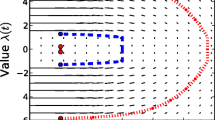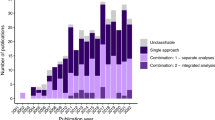Abstract
Population dynamics of migratory species can be modeled using spatial bipartite networks in which nodes representing breeding and winter regions are distributed longitudinally and connected by links representing migratory movements. Understanding the factors that influence the connectivity and population size of such networks is important for effective conservation. In migration ecology terminology, strong migratory connectivity is a network with low node degree and weak or diffuse connectivity is a network with high node degree. We present a model of migration networks using a Lotka-Volterra system of differential equations in which each winter-breeding link is represented as a subpopulation which competes with other subpopulations that share breeding or winter regions. We analyze how habitat distribution and relative costs of migration paths affect the coexistence of subpopulations and hence, the connectivity pattern (weak, moderate or strong). We find that, in the absence of dispersal among subpopulations, strong connectivity occurs when winter habitat has the same longitudinal distribution as breeding habitat, and/or costs of cross-longitudinal migration are high. Moderate connectivity arises otherwise. Total population size is maximized when each longitudinal region has the same amount of breeding habitat as winter habitat and decreases with the costs of migration. Including dispersal leads to weak connectivity and reduces population size. Our results suggest that actions that conserve habitat so as to preserve matching habitat distributions and minimize costs of migration would be most effective.




Similar content being viewed by others
Availability of data and material
Not applicable
Code availability
Mathematica code used in the analysis of this work is available in the supplementary information. We also provide a pdf of the code if a reader does not have access to Mathematica.
References
Anderson CM, Gilchrist HG, Ronconi RA, Shlepr KR, Clark DE, Weseloh DVC, Roberston GJ, Mallory ML (2019) Winter home range and habitat selection differs among breeding populations of herring gulls in eastern North America. Mov Ecol 7(1):1–11
Atlantic Flyway Shorebird Initiative. https://atlanticflywayshorebirds.org. Accessed 17 Mar 2023
Bauer S, Hoye BJ (2014) Migratory animals couple biodiversity and ecosystem functioning worldwide. Science 344(6179):1242552
Boere G, Stroud D (2006) The flyway concept: what it is and what it isn’t. In: Waterbirds around the world., The Stationery Office, Edinburgh, U.K
Bracey A, Lisovski S, Moore D, McKellar A, Craig E, Matteson S, Strand F, Costa J, Pekarik C, Curtis P, Niemi G, Cuthbert F (2018) Migratory routes and wintering locations of declining inland north american common terns. Auk 135(3):385–399
Bridge ES, Thorup K, Bowlin MS, Chilson PB, Diehl RH, Fléron RW, Hartl P, Kays R, Kelly JF, Robinson WD, Wikelski M (2011) Technology on the Move: Recent and Forthcoming Innovations for Tracking Migratory Birds. Bioscience 61(9):689–698
Cresswell W (2014) Migratory connectivity of Palaearctic-African migratory birds and their responses to environmental change: the serial residency hypothesis. Ibis 156(3):493–510
Dingle H (2014) Migration: The Biology of Life on the Move (2nd Edition)
Finch T, Butler SJ, Franco AMA, Cresswell W (2017) Low migratory connectivity is common in long-distance migrant birds. J Anim Ecol 86(3):662–673
Flockhart DTT, Pichancourt JB, Norris DR, Martin TG (2015) Unravelling the annual cycle in a migratory animal: breeding-season habitat loss drives population declines of monarch butterflies. J Anim Ecol 84(1):155–165
Hahn S, Amrhein V, Zehtindijev P, Liechti F (2013) Strong migratory connectivity and seasonally shifting isotopic niches in geographically separated populations of a long-distance migrating songbird. Oecologia 173(4):1217–1225
Hahn S, Alves JA, Bedev K, Costa JS, Emmenegger T, Schulze M, Tamm P, Zehtindjiev P, Adams KLD (2019) Range wide migration corridors and non-breeding areas of a northward expanding Afro-Palaearctic migrant, the European Bee-eater Merops apiaster. Ibis 162:345–355
Hallworth MT, Marra PP (2015) Miniaturized GPS tags identify non-breeding territories of a small breeding migratory songbird. Sci Rep 5(1):1–6
Hallworth MT, Sillett TS, Wilgenburg SLV, Hobson KA, Marra PP (2015) Migratory connectivity of a Neotropical migratory songbird revealed by archival light-level geolocators. Ecol Appl 25(2):336–347
Harrison XA, Blount JD, Inger R, Norris DR, Bearhop S (2010) Carry-over effects as drivers of fitness differences in animals. J Anim Ecol 80(1):4–18
Hobson K (2005) Stable isotopes and the determination of avian migratory connectivity and seasonal interactions. Auk 122(4):1037–1048
Hofbauer J, Sigmund K (1998) Evolutionary games and population dynamics. Cambridge University Press
Inger R, Gregory R, Duffy JP, Stott I, Vořìšek P, Gaston KJ (2014) Common European birds are declining rapidly while less abundant species’ numbers are rising. Ecol Lett 18(1):28–36
Iwamura T, Possingham HP, Chades I, Minton C, Murray NJ, Rogers DI, Treml EA, Fuller RA (2013) Migratory connectivity magnifies the consequences of habitat loss from sea-level rise for shorebird populations. Proc Royal Soc B: Biol Sci 280(1761):20130325–20130325
James ARM, Abbott KC (2014) Phenological and geographical shifts have interactive effects on migratory bird populations. Am Nat 183(1):40–53
Kirby JS, Stattersfield AJ, Butchart SHM, Evans MI, Grimmett RFA, Jones VR, O’Sullivan J, Tucker GM, Newton I (2008) Key conservation issues for migratory land- and waterbird species on the world’s major flyways. Bird Conserv Int 18(S1):S49–S73
Knight SM, Bradley DW, Clark RG, Gow EA, Belisle M, Berzins LL, Blake T, Bridge ES, Burke L, Dawson RD, Dunn PO, Garant D, Holroyd GL, Hussell DJT, Lansdorp O, Laughlin AJ, Leonard ML, Pelletier F, Shutler D, Siefferman L, Taylor CM, Trefry HE, Vleck CM, Vleck D, Winkler DW, Whittingham LA, Norris DR (2018) Constructing and evaluating a continent-wide migratory songbird network across the annual cycle. Ecol Monogr 88(3):445–460
Kolecek J, Procházka P, El-Arabany N, Tarka M, Ilieva M, Hahn S, Honza M, Jdl Puente, Bermejo A, Gursoy A, Bensch S, Zehtindjiev P, Hasselquist D, Hansson B (2016) Cross-continental migratory connectivity and spatiotemporal migratory patterns in the great reed warbler. J Avian Biol 47(6):756–767
Kramer GR, Andersen DE, Buehler DA, Wood PB, Peterson SM, Lehman JA, Aldinger KR, Bulluck LP, Harding S, Jones JA, Loegering JP, Smalling C, Vallender R, Streby HM (2018) Population trends in Vermivora warblers are linked to strong migratory connectivity. Proceedings National Academy Sciences 115(14):E3192–E3200
Lagass BJ, Lanctot RB, Barter M, Brown S, Chiang CY, Choi CY, Gerasimov YN, Kendall S, Liebezeit JR, Maslovsky KS, Matsyna AI, Matsyna EL, Payer DC, Saalfeld ST, Shigeta Y, Tiunov IM, Tomkovich PS, Valchuk OP, Wunder MB (2020) Dunlin subspecies exhibit regional segregation and high site fidelity along the East Asian Australasian Flyway. Condor 122(4):1–15
Liechti F, Scandolara C, Rubolini D, Ambrosini R, Korner-Nievergelt F, Hahn S, Lardelli R, Romano M, Caprioli M, Romano A, Sicurella B, Saino N (2015) Timing of migration and residence areas during the non-breeding period of barn swallows Hirundo rustica in relation to sex and population. J Avian Biol 46(3):254–265
Lisovski S, Bauer S, Briedis M, Davidson SC, Adams KLD, Hallworth MT, Karagicheva J, Meier CM, Merkel B, Ouwehand J, Pedersen L, Rakhimberdiev E, Charron AR, Seavy NE, Sumner MD, Taylor CM, Wotherspoon SJ, Bridge ES (2020) Light-level geolocator analyses: A user’s guide. J Anim Ecol 89(1):221–236
Marra PP, Norris D, Haig SM, Webster M, Royle A (2006) Migratory Connectivity. In: Crooks KR, Sanjayan M (eds) Connectivity Conservation. Cambridge University Press, Cambridge
Newton I (2010) The migration ecology of birds
Norris DR, Taylor CM (2006) Predicting the consequences of carry-over effects for migratory populations. Biol Lett 2(1):148–151
Ouwehand J, Ahola MP, Ausems ANMA, Bridge ES, Burgess M, Hahn S, Hewson CM, Klaassen RHG, Laaksonen T, Lampe HM, Velmala W, Both C (2015) Light-level geolocators reveal migratory connectivity in European populations of pied flycatchers Ficedula hypoleuca. J Avian Biol 47(1):69–83
Pacific Flyway Shorebird Initiative. https://pacificflywayshorebirds.org/. Accessed 17 Mar 2023
Rael R, Taylor C (2018) A flow network model for animal movement on a landscape with application to invasion. Thyroid Res 11(3):271–280
Ratikainen II, Gill JA, Gunnarsson TG, Sutherland WJ, Kokko H (2007) When density dependence is not instantaneous: theoretical developments and management implications. Ecol Lett 0(0)
Rosenberg KV, Dokter AM, Blancher PJ, Sauer JR, Smith AC, Smith PA, Stanton JC, Panjabi A, Helft L, Parr M, Marra PP (2019) Decline of the North American avifauna. Science 366(6461):120–124
Ruegg KC, Anderson EC, Paxton KL, Apkenas V, Lao S, Siegel RB, DeSante DF, Moore F, Smith TB (2014) Mapping migration in a songbird using high-resolution genetic markers. Mol Ecol 23(23):5726–5739
Ruegg KC, Harrigan RJ, Saracco JF, Smith TB, Taylor CM (2020) A genoscape-network model for conservation prioritization in a migratory bird. Conservation Biology pp cobi.13536 – 10
Sample C, Fryxell JM, Bieri JA, Federico P, Earl JE, Wiederholt R, Mattsson BJ, Flockhart DTT, Nicol S, Diffendorfer JE, Thogmartin WE, Erickson RA, Norris DR (2017) A general modeling framework for describing spatially structured population dynamics. Ecol Evol 8(1):493–508
Sauer JR, Pardieck KL Jr, DJZ, Smith AC, Hudson MAR, Rodriguez V, Berlanga H, Niven DK, Link WA, (2017) The first 50 years of the North American Breeding Bird Survey. Condor 119(3):576–593
Schreiber SJ (2006) Persistence despite perturbations for interacting populations. J Theor Biol 242(4):844–852
Stanley CQ, McKinnon EA, Fraser KC, Macpherson MP, Casbourn G, Friesen L, Marra PP, Studds C, Ryder TB, Diggs NE, Stutchbury BJM (2015) Connectivity of wood thrush breeding, wintering, and migration sites based on range-wide tracking. Conserv Biol 29(1):164–174
Taylor CM (2019) Effects of natal dispersal and density-dependence on connectivity patterns and population dynamics in a migratory network. Front Ecol Evol 7:203–11
Taylor CM, Norris DR (2010) Population dynamics in migratory networks. Thyroid Res 3(2):65–73
Taylor CM, Stutchbury BJM (2016) Effects of breeding versus winter habitat loss and fragmentation on the population dynamics of a migratory songbird. Ecol Appl 26(2):424–437
Taylor CM, Laughlin AJ, Hall RJ (2016) The response of migratory populations to phenological change: a Migratory Flow Network modelling approach. J Anim Ecol 85:648–659
Tonra CM, Hallworth MT, Boves TJ, Reese J, Bulluck LP, Johnson M, Viverette C, Percy K, Ames EM, Matthews A, Slevin MC, Wilson RR, Johnson EI (2019) Concentration of a widespread breeding population in a few critically important nonbreeding areas: Migratory connectivity in the Prothonotary Warbler. Condor 13(2):1181–1115
USFWS: Migratory Bird Program Administrative Flyways. https://www.fws.gov/partner/migratory-bird-program-administrative-flyways. Accessed 17 Mar 2023
Webster MS, Marra PP, Haig SM, Bensch S, Holmes RT (2002) Links between worlds: unraveling migratory connectivity. Trends Ecol Evol 17(2):76–83
Wiederholt R, López-Hoffman L, Cline J, Medellìn RA, Cryan P, Russell A, McCracken G, Diffendorfer J, Semmens D (2013) Moving across the border: modeling migratory bat populations. Ecosphere 4(9):114
Zeeman ML (1995) Extinction in competitive lotka-volterra systems. Proc Am Math Soc 123(1):87–96
Funding
This work was supported by a scholarship award from the James S. McDonnell Foundation to CMT. SP was supported by the Mathematics Department at Tulane University.
Author information
Authors and Affiliations
Contributions
Both authors contributed to the development and analysis of this project as well as the writing of this manuscript.
Corresponding author
Ethics declarations
Ethics approval
Not applicable
Consent to participate
Not applicable
Consent for publication
Not applicable
Conflict of interest
The authors declare no competing interests.
Supplementary Information
Below is the link to the electronic supplementary material.
Rights and permissions
Springer Nature or its licensor (e.g. a society or other partner) holds exclusive rights to this article under a publishing agreement with the author(s) or other rightsholder(s); author self-archiving of the accepted manuscript version of this article is solely governed by the terms of such publishing agreement and applicable law.
About this article
Cite this article
Patel, S., Taylor, C.M. Habitat distribution affects connectivity and population size in migratory networks. Theor Ecol 16, 93–103 (2023). https://doi.org/10.1007/s12080-023-00554-4
Received:
Accepted:
Published:
Issue Date:
DOI: https://doi.org/10.1007/s12080-023-00554-4




